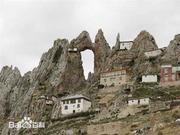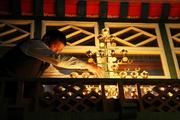Endangered Tibetan talking-singing art recorded for preservation
The culture department in southwest China's Tibet Autonomous Region has finished recording a traditional folk talking and singing performance in order to preserve the dying tradition, the regional cultural protection center announced on Monday.
Known as "Lamamani" in Tibetan, the storytelling technique was once popular in the capital city Lhasa as well as Xigaze and Shannan prefectures. The artists tell Buddhist folktales depicted on Thangka paintings by mixing talking and singing.
Among all the variations of "Lamamani," Lhasa's technique is the most famous.
Trinley, 76, is the only living performer to train directly from masters in the Lhasa style of "Lamamani", said Ngawang Tenzin, deputy director of the protection center.
The center has made detailed images, texts, and video materials surrounding Trinley's life, performance and techniques to ensure the endangered tradition is preserved, Ngawang Tenzin said.
The videos and transcripts will be digitalized and stored in a database, according to the center.
A CD recording of Trinley's performance has been published. The center has also been searching for proper apprentices for Trinley. So far, a folk art troupe in Lhasa has sent four performers to learn from him.
The regional intangible cultural heritage protection center has been interviewing and recording cultural performances by classically trained artists since the beginning of 2015, prioritizing performers above 70 or with illness.
Your Comment
Name E-mailRelated News
-
;
-
-

-
Tibet’s first ancient human ruins restored
The restoration of Tibet’s first ancient human ruins located in Chambo has already been completed.
-
-
-

-
Butter-lamp Day
The Butter-lamp Day is celebrated in Tibet on the 25th day of the tenth month on the Tibetan calendar to commemorate the death of Tsongkhapa, the founder of the Gelug Sect of Tibetan Buddhism.
-











